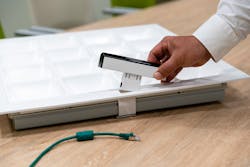A small private school on Long Island that prides itself on ethnic diversity has now added some variety to its wireless Internet technology, installing a Li-Fi system to go along with the existing Wi-Fi Internet service.
In this case, the Li-Fi does not involve any illumination. Lawrence Woodmere Academy has installed Signify Trulifi 6002 LED infrared (IR) transceivers, but has not installed the luminaires that can be part of Signify’s Li-Fi package.
Woodmere worked through Elmont, NY-based June Lite, which served as the integrator on the project. June Lite said the school is using the Li-Fi at its new STEM (science, technology, engineering, and math) center, first in a robotics and gaming area, with the main computing room to follow.
Li-Fi is the technology that transmits data to devices by modulating either light or IR waves rather than using the radio waves of Wi-Fi. Its proponents say it can help offload the saturated Wi-Fi spectrum; that it is more secure because it requires line of sight and thus makes it more difficult for intruders to reach; that it does not emit potentially harmful radio-spectrum radiation; and that it can be faster than Wi-Fi depending on how it is deployed.
Signify introduced its Trulifi 6002 line in 2019, snapping IR transceivers into luminaires and using the IR both for downlinks and uplinks. Prior to that, Signify’s Li-Fi systems used visible light for the downlink to end-user gadgets and IR for the return uplink from the gadgets.
The switch to IR for both directions provided faster speeds and more reliable coverage. It also simplified the engineering of drivers in the systems.
A consequence was that luminaires became optional. LEDs asked Signify to break down the percentage of 6002 installations that are IR only versus IR plus illumination. Signify declined to reveal the ratio.
Woodmere Academy, like other customers, decided on a system that excludes the luminaires but mounts the IR transceivers on the ceiling.
Neither June Lite nor Signify revealed how may transceivers Woodmere is using or how much area the Li-Fi covers. In Li-Fi, coverage varies depending on the height of the transceivers.
The two vendors also did not state how much the school paid for the system. June Lite plants trees around the world based on the value of a sale. It said that it is planting 60 trees in Ethiopia as a result of the school installation.
The Signify spokesperson told LEDs Magazine that Woodmere decided on a “hybrid” Li-Fi/Wi-Fi environment. The school added Li-Fi to the mix “to enhance the speed in which the children are experiencing the varied projects they engage in,” the spokesperson said.
Signify offers two different versions of the 6002. One is rated at 150-Mbps downlink and 140-Mbps uplink, the other at 220-Mbps down and 160-Mbps up. June Lite aspires to install Li-Fi systems that operate at up to 250Mbps. Neither party revealed the actual speed operating at Woodmere.
June Lite noted that Li-Fi can be healthier for students because it does not include any radio waves. The Signify spokesperson said that at Woodmere, “the Wi-Fi will at times be switched off to limit the children’s exposure to radio frequency radiation.”
Signify and other Li-Fi providers have announced a number of small-scale deployments, but large-scale Li-Fi has been slow to catch on in the wider market. Among the reasons are that very few laptop and gadget makers have embedded it. That means end users must attach transceivers — typically USB dongles — to their devices. Presumably, the Woodmere deployment includes dongles. Neither June Lite nor Signify elaborated on that.
One device maker that has embedded Li-Fi is Taiwan-based military provider Getac.
Some Li-Fi pundits believe that LED-based Li-Fi will give way to laser-based Li-Fi, which could provide much faster speeds. (LEDs hopes to bring you a laser Li-Fi update in the next few days).
Lawrence Woodmere Academy has 273 pupils ranging from pre-school age through high school.
“The school culture is marked by a commitment to a global perspective within a school community that is racially, ethnically, and socio-economically diverse,” the school states on its website. According to a U.S. News & World Reports webpage, Woodmere has a 61.3% minority enrollment.
MARK HALPER is a contributing editor for LEDs Magazine, and an energy, technology, and business journalist ([email protected]).
For up-to-the-minute LED and SSL updates, why not follow us on Twitter? You’ll find curated content and commentary, as well as information on industry events, webcasts, and surveys on our LinkedIn Company Page and our Facebook page.






